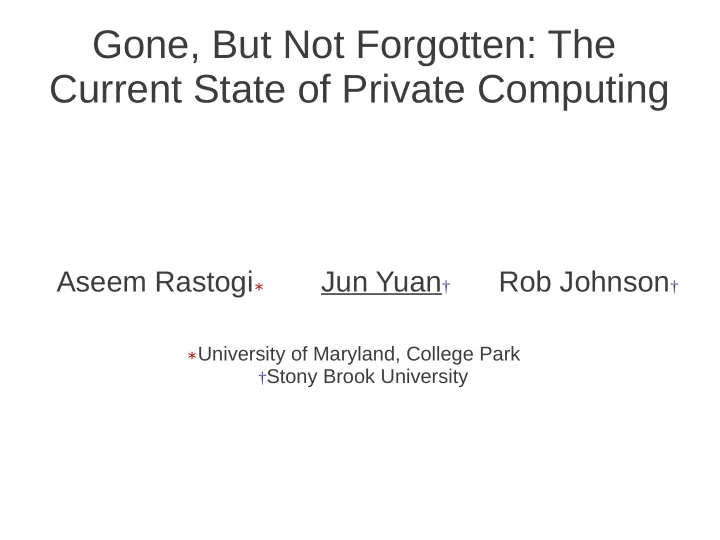

Gone, But Not Forgotten: The Current State of Private Computing Aseem Rastogi ∗ Jun Yuan † Rob Johnson † ∗ University of Maryland, College Park † Stony Brook University
Web browser private mode
Web browser private mode ● Why is the private mode desirable for web browsers? People can use web browser private mode to surf online without leaving a trace on their computers.
More...
Major Themes ● Opinion #1: Private computing should be implemented as a OS service. ● Opinion #2: Private computing should be efficient, usable and complete. ● Opinion #3: Modern OS features and organization will make it practical to make such a private computing service.
Threat Model Passive attacker with Local privilege Can inspect before and after Can inspect every component of the system No key-logger and malicious app: Out of the scope
Web browser private mode ● The current issues of web browser private mode For the local attack, ➢ Software engineering difficulty. Complete mediation by manual code review is hard to achieve.
Web browser private mode ● The current issues of web browser private mode For the local attack, ➢ Software engineering difficulty. Complete mediation by manual code review is hard to achieve. ➢ The traces left in swap, browser memory, kernel buffers and IPC
private data Kernel Proxy Peripheral Device Drivers
IPC Swap Write Kernel Proxy Peripheral Device Drivers
● After the process exits, there are still many spots left with private data Kernel Proxy Peripheral Device Drivers
Web browser private mode ● The current issues of web browser private mode For the local attack, ➢ Software engineering difficulty. Complete mediation by manual code review is hard to achieve. ➢ The traces left in swap, browser memory, kernel buffers and IPC ✔ Extensions and plugins undermines the private mode.
Goals ● Private computing should offer strong assurance of privacy ● Private computing should be lightweight and pay-as-go ● Private computing should not impact user experience The bookmarks in the public mode should be accessible in the private browser mode. ● Private computing should support a variety of applications.
Design of PCM The kernel is patched to erase the kernel buffers, Kernel stack, kernel heap upon recycling Kernel Proxy Peripheral Device Drivers
Design of PCM Union FS Kernel Proxy Peripheral Device Drivers
Design of PCM lxc Union FS Kernel Proxy Peripheral Device Drivers
Design of PCM IPC lxc Union FS Kernel Proxy Peripheral Device Drivers
Design of PCM IPC lxc Union FS Kernel Proxy Peripheral Device Drivers
Design of PCM IPC lxc Union FS Kernel Proxy Peripheral Device Drivers
Design of PCM IPC lxc Union FS swap write Kernel Proxy Peripheral Device Drivers
Upon the exit of the container The addr space of contained processes are zero-ed. lxc Union FS Kernel Proxy Peripheral Device Drivers
Upon the exit of the container lxc Union FS Kernel buffers are zero-ed . Kernel Proxy Peripheral Device Drivers
Upon the exit of the container lxc Union FS Kernel Proxy Peripheral Device Drivers The to-be-retained data decided by policy engine is written to underlying fs
Upon the exit of the container lxc Union FS Kernel Proxy Peripheral Device Drivers The swap which lies in encrypted loop device and to-be-discarded write are automatically discarded once the encryption key is destroyed
Upon the exit of the container lxc Union FS Kernel Proxy Peripheral Device Drivers The proxy of peripheral device (1) zero while unmapping (2) dummy output to overwrite the finite buffer
Related work ● Lacuna[2] ● PrivExec[3]
Reference [1] G. Aggarwal, E. Bursztein, C. Jackson, and D. Boneh. An analysis of private browsing modes in modern browsers. In USENIX, 2010. [2] A. M. Dunn, M. Z. Lee, S. Jana, S. Kim, M. Silberstein, Y. Xu, V. Shmatikov, and E. Witchel. Eternal sunshine of the spotless machine: protecting privacy with ephemeral channels. In OSDI, 2012. [3]Kaan Onarlioglu, Collin Mulliner, William Robertson, Engin Kirda PrivExec: Private Execution as an Operating System Service In Proceedings of the IEEE Symposium on Security and Privacy (S&P) [4] J. Chow, B. Pfaff, T. Garfinkel, and M. Rosenblum. Shredding your garbage: reducing data lifetime through secure deallocation. In USENIX, 2005.
● Private computing should be implemented as a OS service. ● Private computing should be efficient, usable and complete. ● Modern OS features and organization will make it practical to make such a private computing service.
Recommend
More recommend